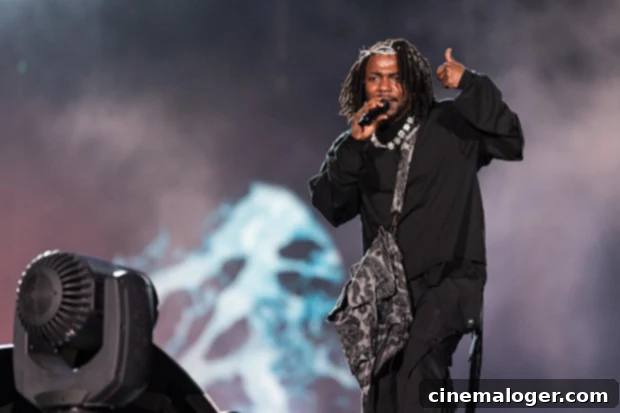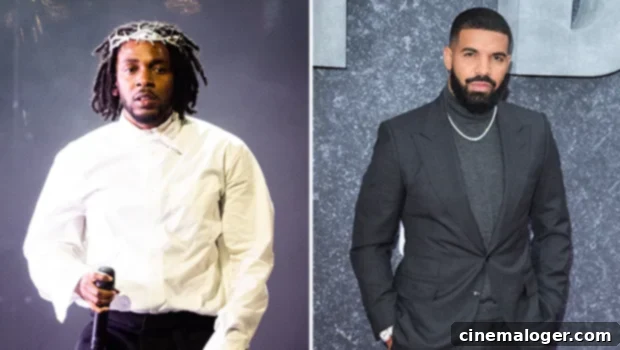Kendrick Lamar’s “Euphoria”: A Surgical Takedown in the Drake Beef and the Battle for Hip-Hop Supremacy
In an explosive turn of events that has sent shockwaves through the hip-hop community, Kendrick Lamar delivered a scathing response to Drake’s recent diss tracks, “Push Ups” and “Taylor Made Freestyle.” On Tuesday, April 30, Kendrick, 36, unleashed the six-minute lyrical assault titled “Euphoria,” a track that meticulously dissected and dismantled his Canadian counterpart, Drake, 37. From the very outset, Lamar left no stone unturned, airing a barrage of grievances and making it unequivocally clear that the gloves were off in this escalating rivalry. The song quickly solidified its place as a pivotal moment in one of modern hip-hop’s most anticipated and heated feuds.
The track kicks off with a calm yet menacing tone, setting the stage for the lyrical onslaught to follow. Kendrick’s intro verse establishes a foundational accusation against Drake, rapping, “Know you a master manipulator and habitual liar too/But don’t tell no lies about me, and I won’t tell no truths ’bout you.” This opening salvo immediately framed Drake as dishonest and untrustworthy, laying the groundwork for the deeply personal and career-threatening jabs that punctuate the rest of the song. The implication here is profound: Kendrick suggests he possesses damning truths about Drake, holding them in reserve but prepared to deploy them if the conflict persists. This strategic warning shot resonated deeply with listeners, hinting at a much darker underbelly to their public personas.
Following this initial declaration, the beat shifts, intensifying the urgency and focus of Kendrick’s message. He then pivots to a highly controversial aspect of Drake’s “Taylor Made Freestyle”: the use of artificial intelligence (AI) to emulate the voices of legendary rappers Tupac Shakur and Snoop Dogg. Kendrick’s disgust is palpable as he raps, “Somebody had told me that you got a ring, on God, I’m ready to double the wage/I’d rather do that than let a Canadian n***a make Pac Turn in his grave.” This line wasn’t just a jab; it was a profound accusation of disrespect towards hip-hop’s sacred cows. For Kendrick, Drake’s deployment of AI to mimic Tupac was not merely a creative choice but an affront to the legacy of one of rap’s most revered figures. This sentiment tapped into a broader debate within the music industry about artistic integrity, intellectual property, and the ethical boundaries of AI in creative endeavors, positioning Kendrick as a defender of authentic artistry against perceived gimmickry.
“Euphoria” also revisited the genesis of the current beef, specifically calling out J. Cole‘s verse on Drake’s song “First Person Shooter.” In that track, Cole infamously declared himself, Kendrick, and Drake as the “Big Three” of contemporary rap. Kendrick, however, unequivocally rejects this notion, reaffirming his sole claim to the throne. “It’s three GOATS left, and I seen two of them kissin’ and huggin’ on stage,” he raps, a thinly veiled dismissal of any perceived camaraderie or shared status among them. His follow-up, “The crown is heavy, huh,” serves as both a taunt and a declaration of his belief that he alone is fit to bear the weight of rap supremacy. This line underscored Kendrick’s consistent refusal to be grouped or sidelined, asserting his unique and unrivaled position at the pinnacle of the genre, a stance he has maintained throughout his career.
As the track progresses, Kendrick delves into more personal and deeply damaging territory, targeting Drake’s past and present. He revisits Drake’s infamous beef with Pusha T, which culminated in Pusha T’s explosive diss track “The Story of Adidon.” That song publicly revealed Drake’s then-secret son, Adonis, whom he had not acknowledged. In “Euphoria,” Kendrick takes this narrative further, launching a direct attack on Drake’s parenting abilities. With the line, “I got a son to raise, but I can see, you don’t know nothin’ ’bout that,” Kendrick implies that Drake is an absent or inadequate father. This particular jab crosses a significant line in rap beefs, moving beyond lyrical skill and artistic merit to deeply personal accusations that can have lasting real-world implications, adding an unprecedented level of intensity to their feud.

The Ignited Feud: A Timeline of Escalation
While the underlying tension between Drake and Kendrick Lamar has simmered for years, marked by subtle jabs and perceived slights in various songs, it truly erupted into a full-blown lyrical war with a precise timeline of events. The catalyst can be traced back to J. Cole’s now-infamous verse on Drake’s “First Person Shooter,” released as part of Drake’s album *For All The Dogs*. In this track, Cole positioned himself, Kendrick, and Drake as the undisputed “Big Three” of modern rap, a statement that many interpreted as an attempt to consolidate a shared reign. However, Kendrick Lamar has historically resisted such groupings, consistently asserting his singular dominance.
Kendrick’s initial, definitive response arrived on March 22, 2024, with his guest verse on Metro Boomin and Future’s collaborative album, *We Don’t Trust You*. On the track “Like That,” Kendrick didn’t mince words, delivering an immediate and aggressive counter to the “Big Three” narrative. His pivotal line, “Motherf*** the Big Three, n***a, it’s just Big Me,” was an unmistakable declaration, directly dismantling Cole’s assertion and simultaneously challenging Drake’s position. This verse instantly went viral, setting the rap world ablaze and shifting the entire narrative, making it clear that Kendrick was not interested in sharing any crown.
The ball then returned to J. Cole’s court, who responded with his diss track “7 Minute Drill.” Released just a few days after “Like That,” Cole’s track attempted to defend his “Big Three” stance and offered some mild jabs at Kendrick’s discography. However, the track was met with a mixed reception, and surprisingly, Cole quickly disowned it. Within days, he expressed regret for recording and releasing the song, stating it felt “out of character” and that he didn’t want to contribute to the negative energy. He swiftly removed the song from streaming platforms, a move that many perceived as a retreat under the intense pressure of a looming lyrical battle with Kendrick, and a tacit admission of being outmatched.
Shortly after Cole retracted his song, Drake escalated the situation with his own responses. His track “Push Ups” leaked online before its official release. In “Push Ups,” Drake directly targets Kendrick, questioning his allegiance to TDE, his touring schedule, and even making personal digs about his height and perceived inactivity. The song was a direct, unapologetic attack, signifying Drake’s entry into the direct lyrical conflict. Following this, Drake officially released “Push Ups” alongside another track, “Taylor Made Freestyle,” on April 19.
“Taylor Made Freestyle” quickly became a flashpoint for its controversial use of AI. In the song, Drake employed AI-generated voices to emulate Tupac Shakur and Snoop Dogg, with these AI versions delivering lyrical jabs at Kendrick. The intention was likely to leverage the iconic status of these legends to bolster his own diss. However, this move backfired spectacularly. Tupac Shakur’s estate released a swift and stern statement, threatening legal action over Drake’s unauthorized and ethically dubious use of AI to mimic the late rapper’s voice. Faced with potential legal repercussions and a significant backlash regarding artistic integrity, the Views rapper promptly deleted “Taylor Made Freestyle” from all platforms, highlighting the unintended and severe consequences of his creative choices.
Broader Implications and the Battle for Hip-Hop Authenticity
This ongoing lyrical war between Kendrick Lamar and Drake extends far beyond personal animosity; it represents a clash of ideologies and a significant moment in hip-hop history. For many fans and critics, Kendrick embodies a certain purist, lyrical integrity—a rapper known for his intricate storytelling, profound social commentary, and uncompromising artistic vision. Drake, on the other hand, is often seen as the commercially dominant force, a pop-culture phenomenon who effortlessly blends rap with R&B, crafting chart-topping hits and redefining mainstream success. The beef, therefore, often frames itself as a battle between artistic authenticity and commercial appeal, between intricate lyricism and widespread accessibility.
The intense fan engagement surrounding this beef underscores its cultural significance. Social media platforms are ablaze with discussions, memes, analytical breakdowns of each lyric, and predictions for the next move. This level of public discourse harkens back to legendary rap rivalries like Nas vs. Jay-Z or Tupac vs. The Notorious B.I.G., where the stakes were not just album sales, but legacy and the very title of “King of New York” or “King of the West Coast.” In this modern context, the prize is the undisputed title of “King of Rap” in a globalized era.
Each track dropped serves as a public declaration, a carefully constructed argument designed to undermine the opponent’s credibility, talent, and even character. Kendrick’s “Euphoria,” with its surgical precision and deeply personal attacks, particularly those concerning Drake’s parenting and alleged manipulative tendencies, raises the stakes to an unprecedented level. It forces listeners to reconsider the public image of both artists, adding layers of complexity to their personas. The AI controversy surrounding “Taylor Made Freestyle” also sparked vital conversations about technology’s role in art, intellectual property rights, and the delicate balance between innovation and reverence for legacy within the music industry.
What’s Next in Hip-Hop’s Biggest Battle?
As the dust settles from “Euphoria,” the hip-hop world collectively holds its breath, anticipating Drake’s inevitable counter-response. The intensity of Kendrick’s attack, particularly the personal nature of some of his jabs, suggests that Drake cannot afford to deliver anything less than an equally impactful and definitive rebuttal. The narrative has now shifted dramatically, with Kendrick arguably seizing the momentum and positioning himself as the dominant force in this exchange. The question remains: how will Drake, known for his strategic responses and ability to craft compelling narratives, respond to such a comprehensive takedown? This ongoing lyrical combat is more than just a rap beef; it is a live-action spectacle defining the legacies of two of the greatest artists of their generation, solidifying their places in the annals of music history for years to come.
